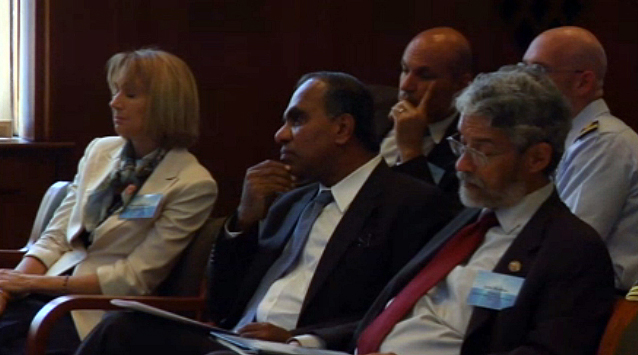|
Capital improvementBlue Ribbon Panel recommends major investment in USAP infrastructurePosted July 25, 2012
An independent committee charged with assessing the logistics requirements for the U.S. Antarctic Program (USAP) The call to action came during a press conference held at the National Academy of Sciences In the report, the 12-member panel, chaired by Norm Augustine 
NSF Director Subra Suresh listens to the results of the Blue Ribbon Panel review during a July 23 press conference at the National Academy of Sciences in Washington, D.C.
“We will take this report extraordinarily seriously and work very hard so that our actions match the drive and goals that were behind producing this report by this distinguished group,” said NSF Director Subra Suresh The Blue Ribbon Panel report on logistics and science support follows a 2011 National Research Council study, Future Science Opportunities in Antarctica and the Southern Ocean, which identified some of the major research goals in Antarctica for the next couple of decades. That group, chaired by Dr. Warren Zapol at Harvard Medical School John P. Holdren “The work that U.S researchers have conducted in our Antarctic program has generated insights into atmospheric and ocean processes, the pace and consequences of climate change, the biology of ancient life, and the origins of the universe — to mention just some of the areas involved. And, yet, clearly there is still much more we can learn from that frozen continent,” he said Monday. “It’s our responsibility as explorers, curiosity-seekers and residents of this remarkably diverse planet to persevere despite the challenges, and do so in a manner that is both cost effective and environmentally responsible,” he added. 
Photo Credit: Zee Evans/Antarctic Photo Library
Divers work on the pier at Palmer Station, one of the pieces of infrastructure in need of replacement.
In the report’s executive summary The report stated, “The Panel identifies the lack of a capital budget for the [USAP] as the root cause of most of the inefficiencies observed — a situation that no successful corporation would ever permit to persist. If a formal, federally endorsed capital budget cannot be provided, then NSF should, at a minimum, formulate a capital plan for U.S. activities in Antarctica that adapts to the needs of science and can be used as a basis for subsequent annual budgeting. The funding of maintenance would likewise benefit from more rigorous planning.” The panel members visited all three USAP research stations at McMurdo, Palmer and South Pole “Today, the South Pole Station is in relatively good shape. Unfortunately, one can’t say that for the facilities at McMurdo and at Palmer,” Augustine said as he cited several examples during the press conference, such as inefficient warehousing at McMurdo and the deficient pier at Palmer. The former was established in the mid-1950s for the International Geophysical Year |



For USAP Participants |
For The Public |
For Researchers and EducatorsContact UsU.S. National Science FoundationOffice of Polar Programs Geosciences Directorate 2415 Eisenhower Avenue, Suite W7100 Alexandria, VA 22314 Sign up for the NSF Office of Polar Programs newsletter and events. Feedback Form |


